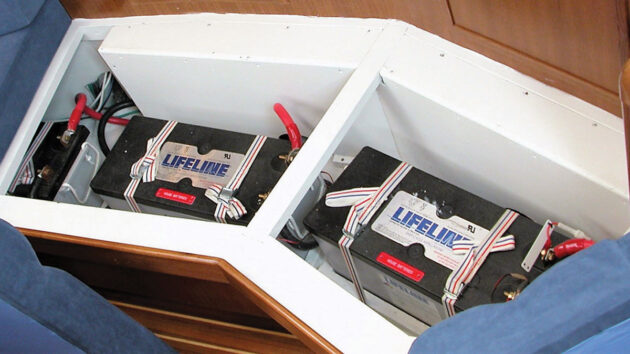Chris Mardon is struggling to understand why his boat battery is not holding a charge. Duncan Kent has some suggestions
My sailing yacht Spook has two AGM lead/carbon service batteries of 110Ah each in parallel on a 12V system.
It has many items connected including a NASA battery monitor.
A mysterious fault has arisen in that the batteries look 90% state of charge (SoC) when we go to bed but have collapsed to 10V by 8am the next morning.
We run the engine for two hours and the batteries charge up to 90% and 12.9V which is maintained by the solar panel during the day.
We have had no 240V power available on a visitor pontoon. We’ve switched every circuit off and on but none have drawn unusual current.
The fridge shuts down automatically when the voltage drops below a set point (around 12V I think), and we have switched off all other electrical circuits except lights overnight.
At 1am the monitor showed the battery voltage at 12.8V but at 7am it had collapsed to 10.9V.
The batteries are four years old and have always been kept at over 89% SoC on a 240V charger when on her marina berth.
Do you have an opinion as to what you think are the most likely causes for this mysterious voltage collapse?
I bought the lead/carbon AGMs because they were supposed to have a much longer life than lead-acid batteries. Could one have failed? How can I tell?
Chris Mardon
Duncan Kent replies: Four years is not an unreasonable lifespan for lead-acid marine house batteries, even the more advanced AGMs like yours.
AGMs usually last longer than regular flooded or VRLA batteries, but they are very fussy about how they are charged.
They need to be fully recharged frequently (preferably using a smart mains charger) to retain their capacity.
Two common problems often occur.

Battery not holding a charge: AGM batteries are fussy about how they are charged. Credit: Barney Green
Firstly, the percentage state of charge (SoC) reading on any battery monitor is almost always inaccurate unless you follow a very rigid charge and resynch protocol, so folk often think they’re fully charging the battery when they’re actually not.
Secondly, I’d always check the voltages at the batteries themselves using an accurate multimeter, after disconnecting all loads and charge sources and waiting an hour.
If you suspect a faulty cell then separate them, charge each battery separately, then test by putting a known load on each one for a specific period of time.
When running your engine, they should show a voltage of around 14.4V initially.
If not, then I suspect a faulty alternator.
You don’t say what mains charger you have but it’s also important to ensure it is set to the AGM charge regime.
I have no idea what loads you have been running on them, but if they’re dropping below 11.0V at any time other than when there’s a very heavy current draw such as an inverter, then I’m afraid they’re very likely to be scrap now.
Marine alternator troubleshooting
Ali Wood gets to grips with Maximus’s faulty electrical system after some unexpected failures made an appearance on passage
5 top causes of boat engine failure – and how to avoid them
Jake Kavanagh talks to Sea Start marine engineer Nick Eales about how to avoid the five major causes of an…
What battery capacity? Working out your boat’s power requirements
In order to work out your boat’s battery capacity you need to know how much power you’re going to draw,…
Boat batteries 101: Which battery is the best choice for my boat?
We’d borrowed a lead acid battery from our marine electrician, Adam McMenemy, which would get the Maxi 84 afloat and…
Want to read more practical articles like Why is my boat battery not holding a charge?

A subscription to Practical Boat Owner magazine costs around 40% less than the cover price.
Print and digital editions are available through Magazines Direct – where you can also find the latest deals.
PBO is packed with information to help you get the most from boat ownership – whether sail or power.
-
-
-
- Take your DIY skills to the next level with trusted advice on boat maintenance and repairs
- Impartial in-depth gear reviews
- Practical cruising tips for making the most of your time afloat
-
-
Follow us on Facebook, Instagram, TikTok and Twitter








